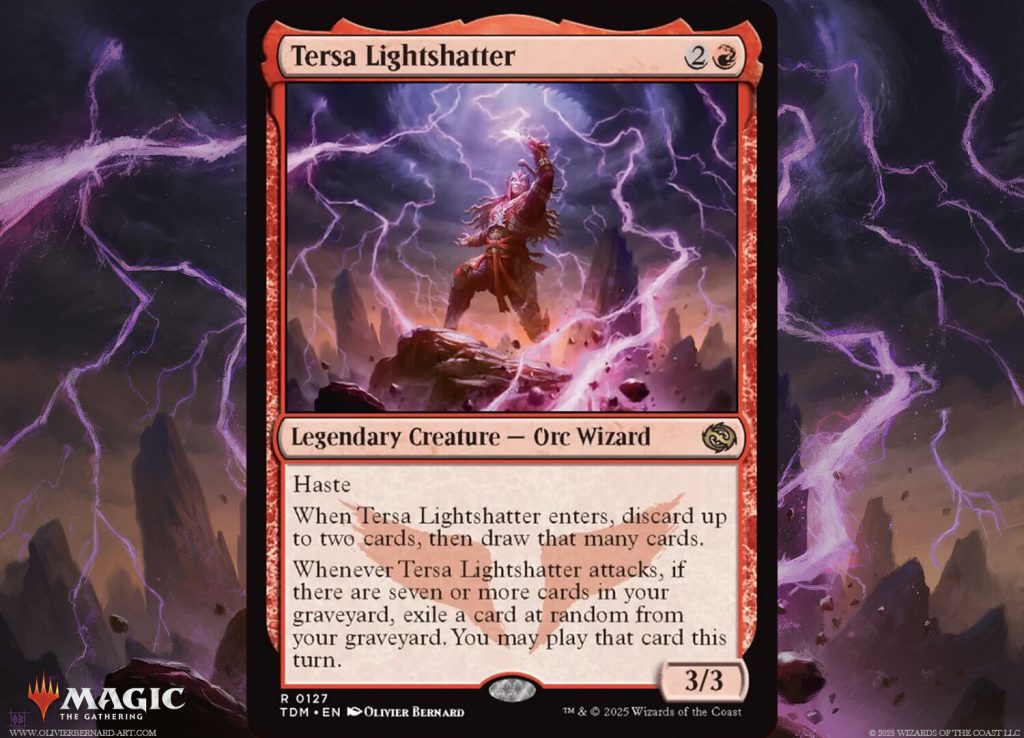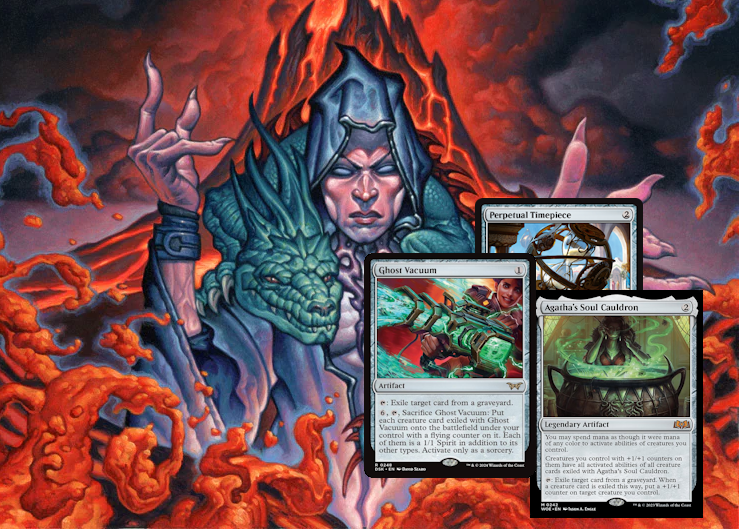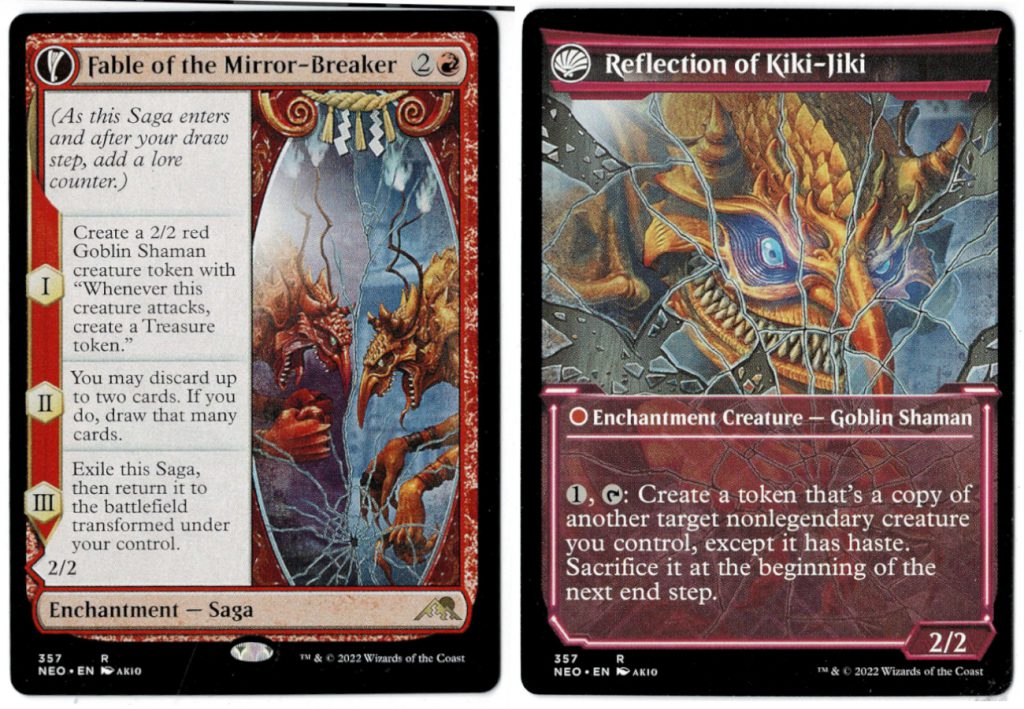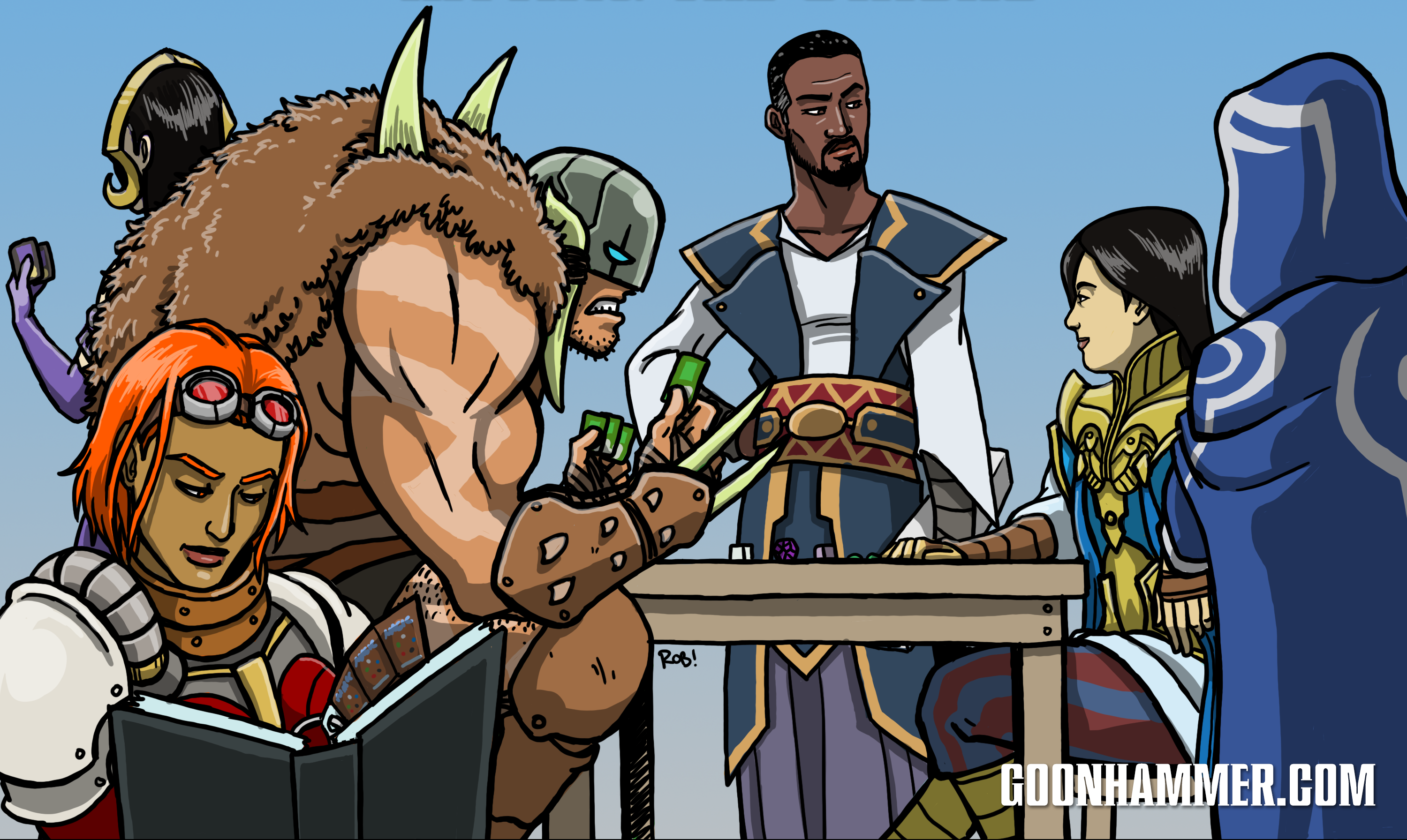When people talk about variance in Magic, they’re often referring to positions of power, depending on the cards available to them throughout the course of a game. This can be as simple as seeing your combo pieces early, getting off to an ideal curve in midrange, or cursing Richard Garfield as they’re being mana-screwed. Every deck has variance, but some decks have more than others—coin flips come to mind, as do die rolls, normally being 1-in-2 and 1-in-6 odds, respectively. But what about 1-in-7? Can you push the boundaries of the game’s speed and power, do everything a color’s best at, and look great while doing so, all on a strict probability worse than rolling a 6? I want to talk today about one of my new favorite cards, debuting in Tarkir: Dragonstorm, Tersa Lightshatter, and how a 60-card design can blossom in EDH.
In this series, I aim to examine some of the most popular & powerful Legendary Creatures from across Magic’s 60-card formats, with Tersa being the 3rd most popular in Standard right now. She serves as the top end to a variety of Red aggro strategies, helping find that one last piece of gas, or burn spell from the yard, to push for damage against control decks. Not only that, Tersa has seen play in Pioneer’s version of Red Deck Wins, with the added benefit of a far greater swath of burn options to pull from. Moreover, the list showcased in this deep dive pulls from my favorite Standard deck of all time, Izzet Hellraiser, as we likewise aim to offset randomness with clones and raw card quality.
In a Commander context, while she might read as a fun, wacky way to spit out Red nonsense, I suspect Tersa might just be the new queen of Monored goodstuff in Commander. While Torbran, Thane of Red Fell once held this mantle, he’s since fallen from grace with competitors being printed in 2+ colors, functionally driving the Dwarf to obsolescence. What sets Tersa apart comes down to the proper application of something the color wouldn’t touch before: Our own suite of grave hate.
Get out your Ghost Vacuums and set that Harvest Pyre ablaze, because we’re going to push Tersa to her limits.

“At Random”
Let’s quickly review Tersa’s text to set the ground rules for this exploration. For starters, having Haste, Rummage for up to 2 on Enters, and an attack trigger make for a pretty explosive 3 mana Commander. This is a card designed, I believe, for 60-card magic, and it has the initial read of some unholy fusion between Seasoned Pyromancer & Kiora, the Rising Tide. Then, her second piece of text: “…if there are seven or more cards in your graveyard, exile a card at random from your graveyard. You may play that card this turn.” Unfortunately, because this checks on resolution, you need to start the trigger’s resolution with 7 cards in the yard, and cannot reduce the number using an effect on the stack; at best, you will always be taking that 1-in-7 odds for any given card, or worse, if you have a stocked graveyard. You can play that card, meaning hitting a land isn’t necessarily bad, and critically, unlike her contemporary in Capricious Hellraiser, the card isn’t exiled and copied, it’s the genuine article. That means once the card is played, and potentially hits the graveyard again, it’s back in the pool. This helps a ton, and means that so long as you can play the card you exile, the only way resources leave the potential pool are if your opponent removes them, or you do.

This isn’t the first time a seemingly random effect has seen potential merit, and as mentioned, Capricious Hellraiser formed the core of one of the most skill-testing Standard decks in recent memory. This deck utilized Planeswalkers & multiple-clone effects like Season of Weaving to duplicate itself and swing in for lethal, all based on tuning exactly what was in the graveyard. While cloning Tersa herself might not be the most ideal, given her Legendary status, this idea of giving a pilot the best possible chance to hit an effect through redundancy, and only playing cards that either get you to that effect, or are that effect, is possible. Enter, grave hate…for yourself.
Pulling Weeds
While not printed on the card itself, Tersa effectively has Threshold, meaning you need to hit 7 cards in the graveyard to even have her effect do anything. Of course, her Enters effect gets you 2/7ths of the way there, but it’s important we not only hit 7 quickly, but also do our best to keep those ~7 cards as all fantastic hits. There’s a push-and-pull there, between racing to 7 and then easing up, and tuning what’s left to get the most out of her ability, and it makes use of some spectacularly weird cards. The only Delve card in Red, Magmatic Sinkhole, represents a way to clear 5 cards of our choice from the grave, and Harvest Pyre clears any number, meaning we can shave down to 7 after something like a board wipe. Grim Lavamancer, once a Legacy staple, is superb here as a way to get rid of hatebears and clear 2 cards from the grave each turn, with Pit of Offerings providing a 1-time clear 3 on a land.
Agatha’s Soul Cauldron is also incidentally great here, getting Tersa bigger, potentially stealing or duplicating activated abilities, and serving as grave hate all in one; as you can likely start to see, turning our yard into a pristine garden of ideal hits isn’t that difficult, and comes with the upside of shoring up one of red’s main weaknesses, being graveyard decks. Monored Commanders won’t have access to stuff like Rest in Peace or Scavenging Ooze, so all of our pieces doing double duty gives us an edge. One absolutely adorable micro-interaction also comes in the form of Collect Evidence, in cards like Detective’s Phoenix & Cryptex, both fantastic ways to repeatedly clear out our graveyard. Collect Evidence merely states that you need to exile cards with total mana value X or greater from your graveyard, meaning any instance of Collect Evidence clears out every land, on top of whatever else, making something like Cryptex an absurd mana rock in Tersa, by a wide margin the best 2+ mana value rock we can play. While effects that use the graveyard as a battery or source of cost don’t often see play, much less in Red, their ability to prune specific cards from Tersa’s pool are essential to running smoothly.

No Bad Cards
So, the basic premise of loading our graveyard, pruning the cards we don’t need, and then going gambling between 7 good options seems sound, but the question then arises: What are we trying to gamble for? There’s a few answers, but the most obvious is extra combat spells; if we successfully hit, cast, and resolve an extra combat spell, it gives us another pull on the Tersa slot machine, and additional triggers from our other cards when we go to combat. In a worst-case scenario, it’s putting out a bit of extra damage, and ‘digging’ for a potential different card, but in a best-case scenario, we’re overwhelming the table with triggers and value. This is where cards like Fury of the Horde & Overpowering Attack shine, as if they were merely given Flashback or some other way to recast, as Red so often does, their alternate costs couldn’t be paid. The fact Tersa is just a flat ‘play’ from exile means we can make great use of alternate means of casting, such as exiling cards, reduced mana costs, and more.
Beyond that, there’s one other suite of cards Red has a wealth of redundancy of, and that’s temporary clones. Calling back to our Izzet Hellraiser Standard example, these allow us to make great use of things already on the board, doubling ETBs, comboing off, or even just filtering two more cards with an extra Tersa, if push comes to shove. While Dualcaster Mage lines are the most well-known use case for these cards, we can also double up on extra combat pieces like Combat Celebrant or Fear of Missing Out, or even the very literal Capricious Hellraiser, depending on how dense our yard is. With enough combats, we’re either winning or hitting exactly what we need, so a wealth of options is paramount to any Tersa deck.

In order to benefit from extra combats, we have cards like Inti, Seneschal of the Sun, Professional Face-Breaker, and Rose, Cutthroat Raider, as well as enchantments like Curse of Opulence and Guild Artisan. If we make mana on attack, we’re far more likely to be able to play whatever card we hit with Tersa, and alongside rituals in the graveyard, we can actually sculpt our way to a win with Aggravated Assault. Of course, there’s also combos there with any repeated cloner/clone spell and FOMO or Celebrant, Kiki-Jiki, Mirror Breaker chief among them, but because of the flexible nature of the deck, it’s very easy to stumble your way into a non-deterministic combo that ends up winning.
When I say non-deterministic, I mean it’s far less automatic or obvious than putting together an empty deck and Thassa’s Oracle, requiring you do a bit of sculpting, gambling, and going through the motions to actually come out ahead. This was made famous by the prohibited ‘Four Horsemen’ deck that had a preposterously high winrate, if it performed its loop thousands of times, waiting for the right permutation of mills, in sequence. You thankfully won’t be here that long with Tersa, but looking to piece together the right line of goodstuff is absolutely in the cards. After all, while 1-in-7 isn’t great odds for any singular card, if all 7 of those cards are good, you’re never unhappy with the roll. I think part of the appeal with this strategy is in how much it borrows from 60-card formats, when they’re so often forgotten by Commander players; not only does Tersa feel designed for Standard itself, but the full 99 cards play closer to a Canlander deck than a synergy-riddled Commander one. In the end, with a well-built Tersa deck, you don’t hate any of the random cards you see, so even if luck doesn’t go exactly your way, you still manage to act like a competent high-power midrange deck.
The Trap of Synergy

One of the biggest ways Commander often differs from contemporary formats is in the most obvious—you have a Commander, and that pushes deckbuilding towards that card. What this means is that people are drawn to seeing terms like ‘Discard’ or ‘Exile’ and slapping together a pile that rewards performing an action over and over. This can work, and depending on who’s leading your deck, that might even be preferable, but when faced with no clear direction, excitement often dwindles. While you can build a ton of discard synergies like Monument to Endurance into a Tersa list, she only discards on Enter, and that card needs density to function. You could add in more randomness like Goblin Lore or Control of the Court, which is at the very least a flavor win and puts cards in your graveyard, but do those cards feel good to hit with her ability? Tersa is a Commander that inspires deckbuilding often polarizing to EDH, including tons and tons of ‘good cards’. Hearing that, you may bring to mind piles like Chulane or Muldrotha, packed with random value cards that serve only to see more good cards, turn after turn, but Tersa benefits greatly from her color identity. Red is, following the various bans, likely the weakest color in Commander, and even at the highest level it’s a toss-up between it and Green. A lot of what’s plainly good in Red isn’t seen as often as that in a multicolor value pile, and moreover, the fact Tersa makes you gamble for it adds variance to gameplay for your opponents, a crucial aspect in such a social game.
If you’re facing down a Tersa, and see a ton of potentially scary cards in that player’s graveyard, even then, you might balk at actually doing something about it. Not only does Tersa have haste, and is cheap enough to be fine with a few removals, the fact her value is semi-random means you might just ‘deal with it when it becomes a problem’. That is precisely why Tersa needs to pack so many good, explosive, flexible wincons, as the strategy is at its best when a lucky (or controlled-for) hit allows you to spiral way out of control. It might seem random from the outside, but given the amount of sculpting we’re able to do, it’s far from it. Fervent Mastery and Dermotaxi are two cards that come to mind when I think of providing a means to win in spite of the randomness, with Tersa making great use of cards in the yard Red normally can’t access, like non-artifact Creatures and Enchantments.
Example Decklist: She Shats Lightning
This list is what I’ve been tuning and testing ever since Tersa was revealed, and while it’s imperfect, I also think it makes fantastic use of everything I’ve described above. You have former Standard all-stars like Capricious Hellraiser and Fable of the Mirror-Breaker, tons of mana acceleration, and a wealth of flatly good cards. Unlike a lot of decks that want to turn on Threshold fast, Tersa is keen to play the cards first, and being in Monored we have a ton of tools to make that happen, from churning through rituals, to moxen, to ample draw. In terms of mulligan, the most important thing is checking whether you’ll be playing goodstuff til Tersa, or whether you have some way to start reaching threshold early, such as Perpetual Timepiece; the game pace you play at will be determined by how quickly you want to, or can, hit her effect. The great news is that even at face, Tersa helps see more cards than quite a few commanders, so curving out aggressively and being the faster deck at the table is entirely possible.
One shocking revelation I made is that Tersa conceptually actually makes sense in CEDH as well, perhaps more than one might think (Shoutout to the Discord). Of course, you need to dedicate more slots to on-stack interaction like Ghostfire Slice, Untimely Malfunction, and Zowoya’s Justice, but the speed at which Tersa comes down, it being a 3/3, and wanting to only play good cards mesh well into midrange metagames within CEDH. I don’t even believe it’s so much a power level concern as it is one of deckbuilding, where you play more efficient removal & interaction to not lose instantly to turbo, but Tersa can provide a surprising amount of value for how little one inputs.
I’ve been able to play Tersa in two test games, and a third with a list full of more CEDH-tuned interaction, and honestly all I can say is that ‘at random’ is a perfect disguise for Red’s strongest soldier, er, Orc Wizard. While it may end up being the case that a Snoop line makes sense, or Goblins overall deserve a larger position in the deck (Such as including Goblin Matron for ease of finding Thornbite Staff lines by way of Kiki-Jiki and Engineer), the scaffolding provided by Tersa is undoubtedly stable, and so long as you control for what you hit, you’ll never be disappointed. While cards come and go quite rapidly in the list, given its identity as a bit of a goodstuff pile, that flexibility and potential to find the ‘perfect’ 99 continues to drive my deckbuilding, especially now that all I need are the new Tarkir cards to play it IRL.
As far as current wincons in the list, the main three of note are FOMO/Celebrant with a cloner, Dualcaster with a clone spell, or Underworld Breach with any number of cards (Birgi + a wheel or Burning Inquiry; Grinding Station with any 0 mana rock, etc). There’s also some non-deterministic loops with Aggravated Assault, for the mathematically masochistic among us, but don’t forget actual combat—we’re still an attack-centric Red deck, and especially in CEDH/lower creature density metas you can put up very reasonable damage very early on.
Spike in Disguise

I want to take a moment to talk about the design process likely behind Tersa being the way it is, and why it’s important we get designs like her in contemporary sets. The fact this is, at minimum, a 3/3 Hasty creature that rummages for 2 would be insane, and an immediate staple in 60 card formats even a few years ago. I began playing the game around Aether Revolt, and the amount of powercreep since then, especially from a standpoint of midrange lists, is hard to fathom. This is a card that needs to do things immediately, because being removed or wiped is extremely common, so extracting some amount of value is necessary for a card to even be considered. This is the same reason cards like Up the Beanstalk draw at-face as well; just having a buildaround, flashy top end isn’t enough from a modern design standpoint.
So you have what is functionally a sidegrade to Seasoned Pyromancer with haste, and if you hit threshold, you get a card you’re already willingly putting in your deck, while putting pressure on the opponent. In 60 card formats, that’s in theory what’s needed to keep up, and I would be shocked if this wasn’t designed to be a top-end threat to the current Mono-Red or Gruul lists. It gets you over the hump, digs for more live cards (and filters out lands), and on occasion finds a pump spell for lethal, wearing cards like Monstrous Rage well enough.
Like so many, you can see ‘at random’ on Tersa, and make the completely normal assumption it’s not for competitive players, as the variance is high, and it only does its best in magical Christmasland. It’s a ‘Timmy’ card, especially in how it urges you to reach for a flashy, seemingly silly payoff, but this belies the power floor of the card, the reason it may actually see play in those 60-card formats: It’s at minimum a 3/3 Haste for 3, that rummages 2, and ‘draws’ you a card.
Everything about Tersa screams 60-card, with no clear buildaround, no obvious synergies, and I think that’s what gives it appeal when nearly every Legendary Creature now is designed, in part, for Commander. It gives you, the player, just enough to dig ones’ teeth into and ‘figure out’, but doesn’t hold your hand. For that reason, I don’t think she’ll garner many fans, but it won’t stop me from spinning that slot machine for combo pieces day-in, and day-out.
Until next time, let’s go gambling.
Have any questions or feedback? Drop us a note in the comments below or email us at contact@goonhammer.com. Want articles like this linked in your inbox every Monday morning? Sign up for our newsletter. And don’t forget that you can support us on Patreon for backer rewards like early video content, Administratum access, an ad-free experience on our website and more.


